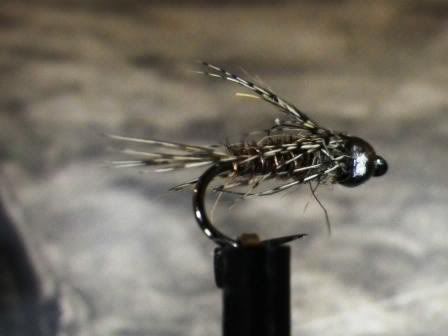Two olive species hatch at this time of year on the River Taff, the March Brown (Rithrogena germanica) and the Large Dark Olive (Baetis rhodani). Not all rivers or even most are lucky enough to have the larger of these two flies, the March Browns but nearly all running water is blessed with LDOs. On most they are the first larger upwing to appear each year and can hatch from the very beginning of the trout season and persist all the way through to its close.
The LDO has two semi-distinct generations, a “slow generation” matures over winter and hatches in spring and the “fast” generation ia hatched in the spring and hatches in the summer and autumn. I have not found any evidence to support this next bit but I am assuming the winter generation is slow simply because it is maturing in colder water and so develops less rapidly. This double generation lifestyle leads to almost year round hatches but the largest generally occur in early spring and autumn and this is when they are most important to us anglers.
The Nymphs
Not my own picture unfrotunately, taken from biopix.com a website with some truly epic insect photography. My photos simply wouldn't do this beautiful creature justice.
The nymphs of these flies are agile darters which are generally accepted to inhabit riffley fast water. They spend most of their time holding on to stones and plants for dear life but are strong swimmers when they decide to move. They are streamlined and relatively large (about 5-10mm) with 3 tails and pronounced wing buds. They are generally found amongst weed and gravel feeding on algae and general organic detritus.
The emergence generally happens from the fast water and the duns can be seen drifting down to the tails of pools at the end of riffles. If LDOs are hatching but the trout are not seen taking them it is well worth trying some nymph patterns in the faster water in case the trout are locked on to the emerging nymphs. The nymph patterns are not only useful during a hatch though as these nymphs are present year round in the lower water column and the same flies can be used to represent most of the Beatis.
They are well represented by slim pheasant tail and biot nymphs, often beaded to get the down in the riffles where these nymphs live.
A simple pheasant tail does well, this is tied with a 2mm bead on a size 16 thin gauge hook.
The addition of a CDC hackle often seems to make a difference and adds a lot of movement to the basic pheasant tail scaffold.
 The Endrick's spider uses partridge to add the movement, suggesting legs and life. Again this fly is tied on a size 16 hook, I don't have partridge hackles small enough so use a dubbing loop to achieve the desired length.
The Endrick's spider uses partridge to add the movement, suggesting legs and life. Again this fly is tied on a size 16 hook, I don't have partridge hackles small enough so use a dubbing loop to achieve the desired length.
The Dun
Again not my pic but isn't it stunning.
These are relatively large flies easily identified by their pair of small oval hindwings and the pairs of short veins between the larger veins on their forewings. They have two tails unlike the nymphs and these are well mimicked using highly spread microfibbets. The colour of the duns is different depending on sex and location and their size is variable although generally they are large and dark and, well, olive. Early in the season the flies tend to be about a size 14 but later hatches are smaller and can be down to an 18, this drop in size during the year is also seen in the nymphs although obviously small immature nymphs are present all year round. The hatches tend to be centred around 12-2pm so are angler friendly in that you can concentrate your fishing during the short warm periods in otherwise frigid days.
Generally they are well represented by many of the olive upwing patterns but some of my favourites to fish as emergers and duns are –
Paradun – for fishing the faster water if the fish are taking them as soon as they hatch
CDC Olive – for fishing in the slower water during hatches where the duns are floating a long way
Ducks dun – one of my favourite olive patterns and probably the one I would reach for first, the hackle makes it buoyant enough to fish in fast water but the CDC a convincing footprint for the slow glassy stuff
Greenwell’s Glory – not one I fish personally as I have a phobia of winged flies but it is one of the classic flies for a LDO hatch so has to be included here.
The Spinner
The spinner is not generally of much interest to anglers. The mated females will land on a partially submerged boulder or debris and then crawl underwater with their wings folded back to deposit their eggs near its base.
This means there is no fabled spinner falls as with the BWO and subsequently no rising fish although I am sure they will be picking off any drowned females they can find, some of the males may find their way on to the water but most will eventually die over the land.





 The Endrick's spider uses partridge to add the movement, suggesting legs and life. Again this fly is tied on a size 16 hook, I don't have partridge hackles small enough so use a dubbing loop to achieve the desired length.
The Endrick's spider uses partridge to add the movement, suggesting legs and life. Again this fly is tied on a size 16 hook, I don't have partridge hackles small enough so use a dubbing loop to achieve the desired length.